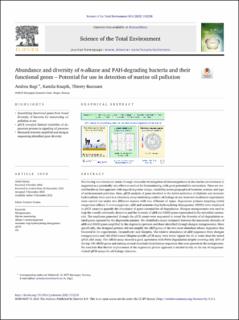| dc.contributor.author | Baussant, Thierry | |
| dc.contributor.author | Knapik, Kamila | |
| dc.contributor.author | Bagi, Andrea | |
| dc.date.accessioned | 2022-06-13T13:07:42Z | |
| dc.date.available | 2022-06-13T13:07:42Z | |
| dc.date.created | 2022-02-08T09:35:46Z | |
| dc.date.issued | 2022 | |
| dc.identifier.citation | Science of the Total Environment. 2022, 810 . | en_US |
| dc.identifier.issn | 0048-9697 | |
| dc.identifier.uri | https://hdl.handle.net/11250/2998558 | |
| dc.description.abstract | Monitoring environmental status through molecular investigation of microorganisms in the marine environment is suggested as a potentially very effective method for biomonitoring, with great potential for automation. There are several hurdles to that approach with regards to primer design, variability across geographical locations, seasons, and type of environmental pollution. Here, qPCR analysis of genes involved in the initial activation of aliphatic and aromatic hydrocarbons were used in a laboratory setup mimicking realistic oil leakage at sea. Seawater incubation experiments were carried out under two different seasons with two different oil types. Degenerate primers targeting initial oxygenases (alkane 1-monooxygenase; alkB and aromatic-ring hydroxylating dioxygenase; ARHD) were employed in qPCR assays to quantify the abundance of genes essential for oil degradation. Shotgun metagenomics was used to map the overall community dynamics and the diversity of alkB and ARHD genes represented in the microbial community. The amplicons generated through the qPCR assays were sequenced to reveal the diversity of oil-degradation related genes captured by the degenerate primers. We identified a major mismatch between the taxonomic diversity of alkB and ARHD genes amplified by the degenerate primers and those identified through shotgun metagenomics. More specifically, the designed primers did not amplify the alkB genes of the two most abundant alkane degraders that bloomed in the experiments, Oceanobacter and Oleispira. The relative abundance of alkB sequences from shotgun metagenomics and 16S rRNA-based Oleispira-specific qPCR assay were better signals for oil in water than the tested qPCR alkB assay. The ARHD assay showed a good agreement with PAHs degradation despite covering only 25% of the top 100 ARHD genes and missing several abundant Cycloclasticus sequences that were present in the metagenome. We conclude that further improvement of the degenerate primer approach is needed to rely on the use of oxygenase-related qPCR assays for oil leakage detection. | en_US |
| dc.language.iso | eng | en_US |
| dc.rights | Navngivelse 4.0 Internasjonal | * |
| dc.rights.uri | http://creativecommons.org/licenses/by/4.0/deed.no | * |
| dc.title | Abundance and diversity of n-alkane and PAH-degrading bacteria and their functional genes – Potential for use in detection of marine oil pollution | en_US |
| dc.title.alternative | Abundance and diversity of n-alkane and PAH-degrading bacteria and their functional genes – Potential for use in detection of marine oil pollution | en_US |
| dc.type | Peer reviewed | en_US |
| dc.type | Journal article | en_US |
| dc.rights.holder | © 2021 The Authors | en_US |
| dc.description.version | publishedVersion | en_US |
| cristin.ispublished | true | |
| cristin.fulltext | original | |
| cristin.qualitycode | 2 | |
| dc.identifier.doi | 10.1016/j.scitotenv.2021.152238 | |
| dc.identifier.cristin | 1998894 | |
| dc.source.journal | Science of the Total Environment | en_US |
| dc.source.volume | 810 | en_US |
| dc.source.pagenumber | 14 | en_US |

